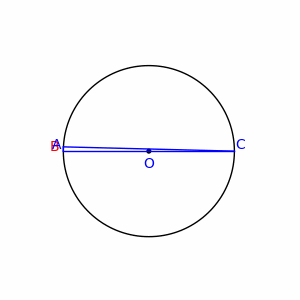Democritus lived in the 5th century BC. He was one of the most celebrated philosophers of the era, and is mostly famous for his theory of 'atoms', namely that after some point in the divisions of something you can only get to having a vast void where infinitesimally smaller parts move around, which he termed as atoms. Atoms (Atoma) literally mean 'indivisible' in Greek, and the reason he developed this theory was to counteract the immediately previous one, by the Eleatic philosophers (such as Zeno and Parmenides), who argued that the divisions never end (and focused on what this would mean).
Democritus, like most other presocratic philosophers, also was interested in concurrent mathematics. It was a period shortly after the first Pythagorians. Democritus posed a question about geometry, which had obvious other consequences (including for his own theory of atoms). It was the following one:
-If one divides a perfect cone, using a plane, then at the two immediate points where the cone was divided you would have on each side two points in the outer surface, but would the point nearer to the base of the cone be countably larger than the point just one further away? (ie in the division location).
He noted that if the answer was 'Yes', that would mean the cone has a step form in its infinitesimal parts. If the answer would be 'No', then in those parts it would be indistinct as a progression in space (something between a cube and a cone, for example).
The question had the obvious link to atoms, since those infinitesimal parts of the cone were to be linked to atoms. In essense the question was whether you could get a visible progression by adding the smallest particle, just once. Mentally, we can always do that. But could it be the same in nature?
In the end the question is about the notion of a 'single point', in Geometry, and whether that notion is really in line ( ) with the external, non-mental world of phenomena.
) with the external, non-mental world of phenomena.
Democritus, like most other presocratic philosophers, also was interested in concurrent mathematics. It was a period shortly after the first Pythagorians. Democritus posed a question about geometry, which had obvious other consequences (including for his own theory of atoms). It was the following one:
-If one divides a perfect cone, using a plane, then at the two immediate points where the cone was divided you would have on each side two points in the outer surface, but would the point nearer to the base of the cone be countably larger than the point just one further away? (ie in the division location).
He noted that if the answer was 'Yes', that would mean the cone has a step form in its infinitesimal parts. If the answer would be 'No', then in those parts it would be indistinct as a progression in space (something between a cube and a cone, for example).
The question had the obvious link to atoms, since those infinitesimal parts of the cone were to be linked to atoms. In essense the question was whether you could get a visible progression by adding the smallest particle, just once. Mentally, we can always do that. But could it be the same in nature?
In the end the question is about the notion of a 'single point', in Geometry, and whether that notion is really in line (
 ) with the external, non-mental world of phenomena.
) with the external, non-mental world of phenomena.


 ).
).